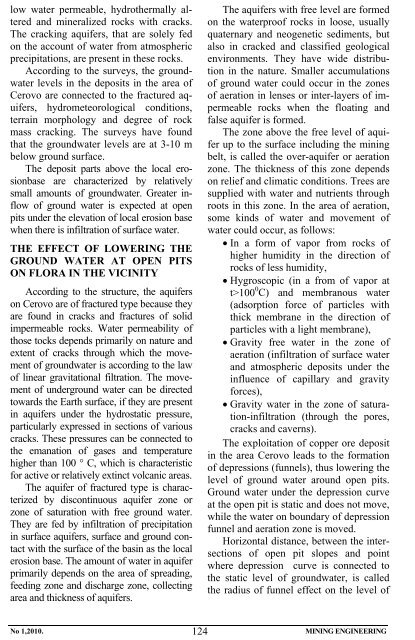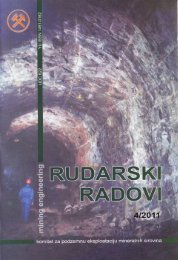Institut za rudarstvo i metalurgiju Bor
Institut za rudarstvo i metalurgiju Bor
Institut za rudarstvo i metalurgiju Bor
You also want an ePaper? Increase the reach of your titles
YUMPU automatically turns print PDFs into web optimized ePapers that Google loves.
low water permeable, hydrothermally altered<br />
and mineralized rocks with cracks.<br />
The cracking aquifers, that are solely fed<br />
on the account of water from atmospheric<br />
precipitations, are present in these rocks.<br />
According to the surveys, the groundwater<br />
levels in the deposits in the area of<br />
Cerovo are connected to the fractured aquifers,<br />
hydrometeorological conditions,<br />
terrain morphology and degree of rock<br />
mass cracking. The surveys have found<br />
that the groundwater levels are at 3-10 m<br />
below ground surface.<br />
The deposit parts above the local erosionbase<br />
are characterized by relatively<br />
small amounts of groundwater. Greater inflow<br />
of ground water is expected at open<br />
pits under the elevation of local erosion base<br />
when there is infiltration of surface water.<br />
THE EFFECT OF LOWERING THE<br />
GROUND WATER AT OPEN PITS<br />
ON FLORA IN THE VICINITY<br />
According to the structure, the aquifers<br />
on Cerovo are of fractured type because they<br />
are found in cracks and fractures of solid<br />
impermeable rocks. Water permeability of<br />
those tocks depends primarily on nature and<br />
extent of cracks through which the movement<br />
of groundwater is according to the law<br />
of linear gravitational filtration. The movement<br />
of underground water can be directed<br />
towards the Earth surface, if they are present<br />
in aquifers under the hydrostatic pressure,<br />
particularly expressed in sections of various<br />
cracks. These pressures can be connected to<br />
the emanation of gases and temperature<br />
higher than 100 ° C, which is characteristic<br />
for active or relatively extinct volcanic areas.<br />
The aquifer of fractured type is characterized<br />
by discontinuous aquifer zone or<br />
zone of saturation with free ground water.<br />
They are fed by infiltration of precipitation<br />
in surface aquifers, surface and ground contact<br />
with the surface of the basin as the local<br />
erosion base. The amount of water in aquifer<br />
primarily depends on the area of spreading,<br />
feeding zone and discharge zone, collecting<br />
area and thickness of aquifers.<br />
The aquifers with free level are formed<br />
on the waterproof rocks in loose, usually<br />
quaternary and neogenetic sediments, but<br />
also in cracked and classified geological<br />
environments. They have wide distribution<br />
in the nature. Smaller accumulations<br />
of ground water could occur in the zones<br />
of aeration in lenses or inter-layers of impermeable<br />
rocks when the floating and<br />
false aquifer is formed.<br />
The zone above the free level of aquifer<br />
up to the surface including the mining<br />
belt, is called the over-aquifer or aeration<br />
zone. The thickness of this zone depends<br />
on relief and climatic conditions. Trees are<br />
supplied with water and nutrients through<br />
roots in this zone. In the area of aeration,<br />
some kinds of water and movement of<br />
water could occur, as follows:<br />
• In a form of vapor from rocks of<br />
higher humidity in the direction of<br />
rocks of less humidity,<br />
• Hygroscopic (in a from of vapor at<br />
t>100 0 C) and membranous water<br />
(adsorption force of particles with<br />
thick membrane in the direction of<br />
particles with a light membrane),<br />
• Gravity free water in the zone of<br />
aeration (infiltration of surface water<br />
and atmospheric deposits under the<br />
influence of capillary and gravity<br />
forces),<br />
• Gravity water in the zone of saturation-infiltration<br />
(through the pores,<br />
cracks and caverns).<br />
The exploitation of copper ore deposit<br />
in the area Cerovo leads to the formation<br />
of depressions (funnels), thus lowering the<br />
level of ground water around open pits.<br />
Ground water under the depression curve<br />
at the open pit is static and does not move,<br />
while the water on boundary of depression<br />
funnel and aeration zone is moved.<br />
Horizontal distance, between the intersections<br />
of open pit slopes and point<br />
where depression curve is connected to<br />
the static level of groundwater, is called<br />
the radius of funnel effect on the level of<br />
No 1,2010. 124<br />
MINING ENGINEERING



